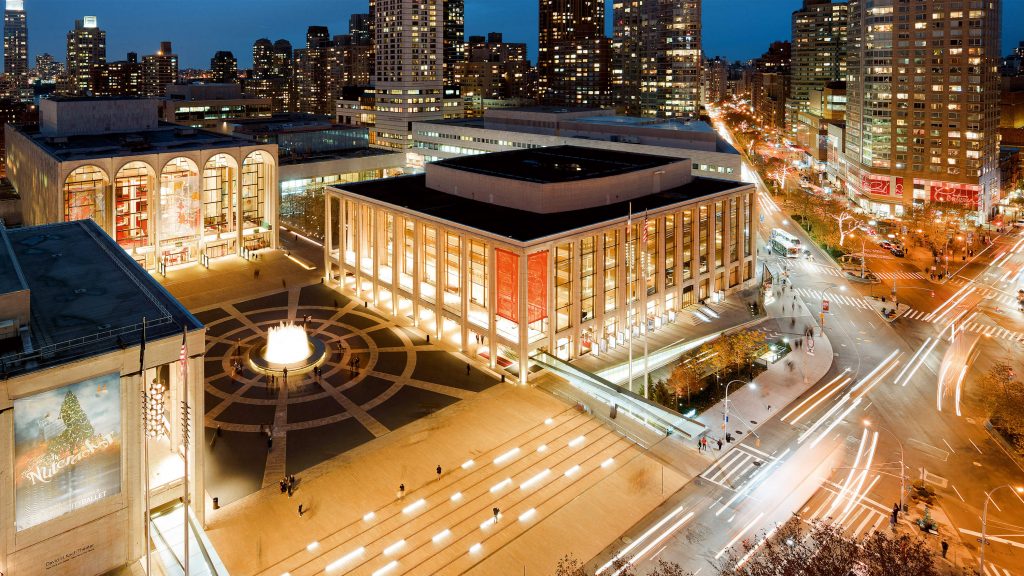Performance Spaces: Lincoln Center

Lincoln Center is one of the finest classical music venues in the world and the ensembles that call it home symbolize the pinnacle of performance for many musicians. The New York Philharmonic and the Metropolitan Opera have deep histories dating back to the 19th century. Despite being some of the oldest major ensembles in the United States, they have been slow to diversify their ensembles and that struggle continues today.
Planning for construction began in 1955 and President Dwight D. Eisenhower attended the groundbreaking ceremony in 1959. David Geffen Hall (formerly Avery Fisher Hall) was the first structure to be finished, opening in 1962, followed by the Metropolitan Opera House in 1964, then the David H. Koch theatre in 1964. The musical groups that call these venues home have a history that extends further than the structures, dating back to the 19th century.
Founded in 1883, the Metropolitan Opera’s first black performers were vaudeville duo Bert Williams and George Walker who took the stage for a fundraising gala in 1897. Other Black performers were supplementary dancers or chorus members until the Bing Years when meaningful change came center stage.
Sir Rudolf Bing, an Austrian born opera impresario, became General Manager of the Metropolitan Opera in 1950. Bing felt that the arts needed to do more to fight discrimination and he went about it strategically. In 1953, Robert McFerrin won the “Auditions of the Air” singing contest. Where the winner would usually receive training and a contract to sing at the Met, McFerrin received extra training but no contract. It took another two years for him to become the first African American man to play a lead role at the Met and then in 1956 he became the first black performer to play a title role at the Met, but not before a woman broke the color barrier on stage.
In 1955, Marian Anderson played Ulrica in Giuseppe Verdi’s Un ballo in Maschera only a few weeks prior to McFerrin’s breakthrough, making Anderson the first African-American to play a lead role on stage at the Met. The role she portrayed was a witch described by Verdi as “a negro.” This was part of Bing’s strategy to not overly shock audiences as he worked to integrate the stage. This was nonetheless a large step for the black community and Anderson herself who had previously been denied performance spaces, notably resulting in the 1939 Memorial Concert. At the time, Washington D.C. was a segregated city and the Daughters of the American Revolution denied Anderson performance rights to Constitution Hall. The District of Columbia Board of Education also declined a request for the use of the auditorium of a white public high school. In response, Anderson played for over 75,000 audience members on the steps of the Lincoln Memorial.
When the New York Philharmonic was founded in 1842, they opened select daytime rehearsals to audiences. This was especially geared toward women, as they could attend without a male escort. But it was forty three years later that a woman would perform with the Philharmonic. At age 18, violinist Maud Powell performed as a concerto soloist in 1888 and became one of the first American Violinists to achieve international success. Then in 1922, Stephanie Golder was hired to be the ensemble’s harpist. After winning a contest three years later, Marian Anderson became the first black woman to appear with the New York Philharmonic, greatly preceding her Metropolitan Opera debut.
It was one hundred and twenty years after its founding that the New York Philharmonic hired its first full time black musician in 1962: Violinist Sanford Allen. He retired after fifteen years, stating he was “tired of being a symbol.”[1] The ensemble has become more diversified since then and in 2014, clarinetist Anthony McGill became the Philharmonic’s first African-American principal player.
The New York Philharmonic still exists as one of the oldest symphony orchestras in the US and the Metropolitan Opera continues to operate as one of the largest musical organizations in North America. The excellence displayed by these ensembles makes it a powerful place for representation, but other major institutions have taken steps much quicker and earlier in their histories.
Carnegie Hall opened in 1891 and in 1982 introduced black performers to its stage with soprano Sissieretta Jones.[2] The New York City opera company was founded in 1943 and featured Todd Duncan in 1945, making him the first African-American to sing with a major opera. He had previously premiered the role of Porgy in 1935 and protested segregation in D.C. theatres in 1938. Henry Lewis became the first black instrumentalist in a major symphony orchestra fourteen years before the New York Philharmonic when he was hired by the Los Angeles Philharmonic. He would go on to be the first African American conductor of the Metropolitan Opera.
Despite long histories rooted in a cultural capital, both the New York Philharmonic and the Metropolitan Orchestra are still struggling to diversify, and they are not alone. Classical music as a whole is still working towards a more diverse field for performers, conductors, composers, administrators, and audiences. Thankfully there are a number of initiatives happening in New York that are working towards a more accessible and representative artistic scene.
[1] Henahan, Donal. “Only Black in Philharmonic Is Resigning After 15 Years.” The New York Times, 29 Aug. 1977, www.nytimes.com/1977/08/29/archives/only-black-in-philharmonic-is-resigning-after-15-years.html. Accessed 14 Apr. 2021.
[2] “Celebrating Black History at Carnegie Hall on Google Arts & Culture.” Celebrating Black History on Google Arts & Culture, www.carnegiehall.org/Explore/Articles/2020/10/21/Celebrating-Black-History-at-Carnegie-Hall#:~:text=Gino%20Francesconi%2C%20director%20of%20the,with%20her%20debut%20in%201920.